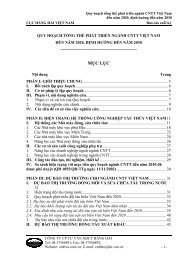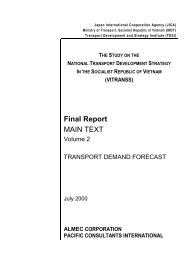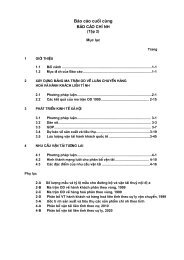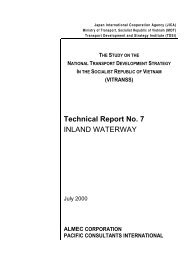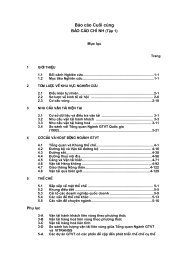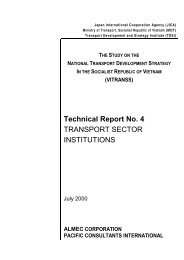Technical Report No. 8 PORT AND SHIPPING
Technical Report No. 8 PORT AND SHIPPING
Technical Report No. 8 PORT AND SHIPPING
You also want an ePaper? Increase the reach of your titles
YUMPU automatically turns print PDFs into web optimized ePapers that Google loves.
6) HCMC (United Kingdom), January 1999<br />
Name of the study: Ho Chi Minh City Transport Study<br />
II-2-4<br />
Vietnam National Transport Strategy Study (VITRANSS)<br />
<strong>Technical</strong> <strong>Report</strong> <strong>No</strong>. 8<br />
Shipping and Ports<br />
Result of the study: The throughput of the port complex (million tons per<br />
annum) is shown in the table below:<br />
Table 2.1.2<br />
Estimated Throughput of the Port Complex<br />
Scenario Year<br />
HCMC<br />
Port Complex<br />
Thi Vai Vung Tau Total<br />
Scenario 1 2000 10.2 4.7 0.0 14.9<br />
2010 10.2 12.4 22.4 45.0<br />
2020 10.2 29.6 35.2 75.0<br />
Scenario 2 2000 11.8 2.4 0.0 14.2<br />
2010 25.0 6.2 4.8 36.0<br />
2020 25.0 14.8 13.4 54.2<br />
Scenario 3 2000 13.1 1.0 0.0 14.1<br />
2010 25.0 4.0 5.5 34.5<br />
2020 25.0 8.0 18.0 51.0<br />
<strong>No</strong>te: Scenario 1: Dispersed development-maximizing activity at Vung Tau and Thi Vai River<br />
Scenario 2: Early investment in HCMC<br />
Scenario 3: Maximizing development in situ in HCMC by mproving Soai Rap River<br />
7) World Bank Transport Sector <strong>Report</strong>, January 1999<br />
Comments: Vietnam’s ports (except some in HCMC) have about five years’<br />
throughput capacity reserves without requiring major new investments. Hence,<br />
government should use this time to:<br />
• assess the likely impact of the Asian economic crisis on its projections of<br />
port traffic and its port investment program:<br />
• review the viability of its industrial and economic development and<br />
investment plans and estimate traffic types and volumes to be generated;<br />
• assess the potential for increasing the throughput capacity and productivity<br />
of existing major maritime ports (with” limited investment”) through port<br />
commercialization/corporatization; improved operational and management<br />
systems, including the introduction of a market-based regulatory and<br />
institutional framework to allow ports to be managed as commercial<br />
enterprises; and<br />
• identify intermodal transport facility requirements, including investments,<br />
timetables, cash flows, and alternate solutions, to handle the additional<br />
traffic created by the planned industrial and economic development.



